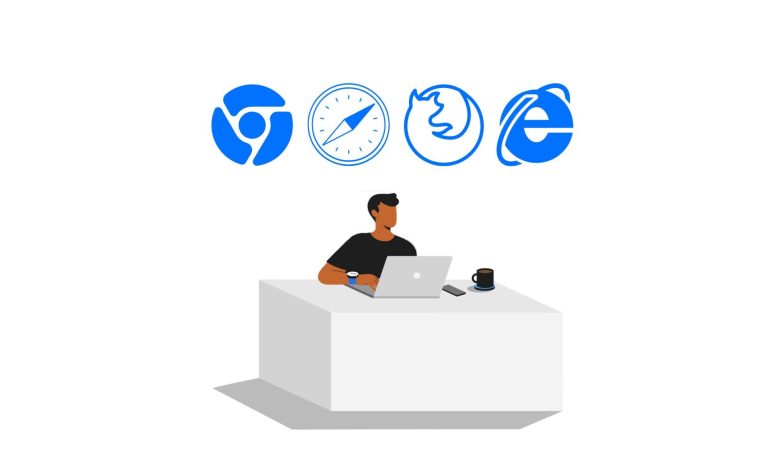
Ensuring Cross-Browser Compatibility is no chore anymore for web developers who want to create a solid digital presence for their clients; it is now a core investment to bring true excellence in user experience.
The web landscape today is diverse, with people accessing the web on hundreds of devices, each with its preferred browser. These browsers can render information differently, causing frustration and losing brand loyalty. Cross-browser testing is crucial for web developers to ensure a seamless experience across different browsers and devices.
By identifying compatibility problems in advance, users can bypass crises, leading to a more trust-based conversion process. This process helps ensure a seamless and user-friendly experience, ultimately benefiting the overall user experience.
This article focuses on strategies and best practices in achieving cross-browser compatibility, where cloud testing will play a significant role, and platforms like LambdaTest help ease this important process.
Understanding Cross-Browser Compatibility
Cross-browser compatibility represents the user experience of your website or web application, it operates without flaw and appears visually consistent over a wide array of browsers.
The inconsistency in web pages due to browser differences can lead to frustration, decreased engagement, and decreased search engine ranking. Users on Chrome may encounter a perfectly functioning website, while other users on Edge may encounter a chaotic mess of displaced elements and broken features.
To avoid this, developers must learn how to master these browsers’ traits quickly. This implies getting into the nitty-gritty of the browser characteristics and capabilities of popular browsers like Chrome, Firefox, Safari, and Edge, to specifically target areas where rendering inconsistencies may be a problem.
Through effective testing strategies, developers can ensure that their websites are accessible, user-friendly, and appealing across all platforms; valuable user trust and loyalty are formed in the constantly competitive digital realm.
Advanced Strategies for Cross-Browser Compatibility: Let’s Tame The Browser Beast
The initial steps towards cross-browser compatibility involve laying a solid foundation for your website. These core strategies ensure a consistent visual experience and functionality across different browsing environments. Following are the ways to ensure cross-browser compatibility,
Responsive Design
A responsive website design is quite necessary for a consistent user experience regardless of the device used. It is a development process whereby web pages render well on various devices and window or screen sizes. In addition, the layout of a web page is optimized for easy reading and navigation with a minimum of resizing, panning, and scrolling.
Vendor Prefixes
To define which browser the rule is intended for, vendor prefixes are often short strings placed at the start of CSS properties. Common examples are -webkit-for Chrome, -moz-for Firefox, and -ms-for Internet Explorer.
With this, a developer can define their CSS style correctly for different browsers. When using vendor prefixes, developers ensure that the CSS style he or she has set up will be displayed correctly on different browsers. This helps to eliminate inconsistent layouts and designs across different browsers.
Automated Testing
Automated testing tools like Selenium and Cypress can simulate complex user behaviors against various browsers and devices to find the tiniest of glitches that could result in pain points for users.
This technique is meant to execute repeated tasks without the risk of human error, thus producing repeated test results. One can automate testing for various aspects of a website, including its functionality, performance, and user interface.
Manual Testing
Automated tests are effective in identifying functional and layout issues, but they may not fully capture user experience subtleties. A hybrid approach, combining automated and manual testing is effective for exploratory and usability testing, allowing human testers to uncover issues that automated tests might not.
Browser Profiling
Browser profiling helps analyze it best for capabilities and limitations in getting cross-browser compatibility. This means that we are trying to identify the rendering engine of the browser, the JavaScript engine, and many other key features that can make the website operational.
Knowing the capabilities of the browser will enable developers to aim the design and functionality of the website at optimal performance.
Feature Detection Support
This can be done by developers using it to test newer technology and provide fallbacks for browsers in which the technology is not supported. Modernizr is helpful in that as it makes it pretty straightforward to enumerate if a new feature is workable in combination with the browser.
This approach will ensure that website functionality is correct in different browsers, even if they are not supported by new technologies.
Clear Cache and Cookies
Clearing the cache and cookies and disabling any extensions or add-ons might removes the problem of browser incompatibility. This approach will ensure that your website is tested in a clean environment without any settings or configurations inside a browser, which might provide different results in the test.
Use of Polyfills
Polyfills involve a small piece of code emulating the behavior of new technologies in older browsers. This feature allows developers to ensure that their website functionality is correct across different browsers, even if the new technologies in it are not supported.
Use of Browser-Specific CSS
Browser-specific CSS involves using CSS styles that are tailored to specific browsers. This approach will ensure that the website looks and works correctly in different web browsers, even if the web browsers have different rendering engines or CSS interpretations.
Use of Browser-Specific JavaScript
Browser-specific JavaScript involves using JavaScript code that is tailored to specific browsers. This approach will ensure that the website runs correctly on different browsers, even if it has distinguished JavaScript engines or interpretations.
Cloud Testing
Cloud testing platforms offer a convenient way to test websites across various browsers without the need to maintain an extensive in-house set of testing infrastructure.
LambdaTest is one such platform that provides a cloud-based platform executed through various real browsers and devices, which allows developers to run tests on different browser versions and operating systems, including mobile devices.
This allows test coverage to be extremely wide in nature while supporting most automation frameworks, such as Selenium, Cypress, and Appium. This makes it very suited for organizations looking for strong, reliable testing solutions.
Best Practices for Cross-Browser Compatibility
Though the previous core strategies make up the backbone for cross-browser compatibility, a winning approach is one in which best practices are followed.
These practices will tweak the development process for exemplary user experiences, no matter the web browser being employed.
Continuous Testing
Continuous testing ensures seamless browsing for all visitors by proactively identifying and resolving issues using the latest browser versions. This approach keeps the website stable and operational on all major browsers, providing users with a consistent and excellent experience.
Regular testing also helps prevent problems from becoming large, leading to downtime and lost revenue. The goal is to keep the website running smoothly and efficiently, delivering a better user experience. Therefore, continuous testing is crucial for maintaining a stable and efficient website.
Feature Detection Support
Feature detection is a tool that enables developers to test and feature-check new technologies, offering fallbacks for browsers that don’t support the technology. Modernizr helps determine if a new feature is compatible with the browser in use, ensuring the website is functional across different browsers and devices.
This not only validates user code to run correctly but also prevents issues related to browser compatibility, preventing degraded user experience. Feature detection support ensures that websites are always compatible with the latest browser versions and technologies, preventing potential issues that may hamper user experience.
Clear Cache and Cookies
Clearing cache and cookies can resolve browser compatibility issues and ensure a clean environment for testing a website. This prevents any configurations or settings that may affect test results. Clearing cache and cookies ensures a new start and prevents breakdowns due to browser-specific settings.
This ensures the website runs properly across all devices and browsers, delivering accurate and reliable test results. This approach ensures a clean and consistent environment for testing, ensuring a reliable and accurate test experience.
Test Across Multiple Devices
Testing across multiple devices ensures a website’s functionality across various platforms like desktops, laptops, tabs, and smartphones. This testing ensures accessibility and usability, addressing issues related to screen size, resolution, and OS disparities.
This ensures compatibility with any browser and device, resulting in a consistent user experience. Developers test on multiple devices to ensure the website is accessible and compatible with any device or platform, ensuring a high-quality experience.
Use Open-Source Tools
Open-source tools like Selenium and Cypress are highly beneficial in cross-browser testing due to their cost-effective and flexible solutions. These tools can be integrated into automation frameworks and testing platforms, making them popular among organizations with robust test needs.
They are highly customizable, allowing developers to match their testing environment with their specific needs. This ensures cost control and increased efficiency without the need for expensive proprietary software. This allows developers to ensure website testing efficiently and effectively, while also prioritizing the company’s interests and user experience.
Use of Browser-Specific Tools
Browser-specific testing tools provide comprehensive environments for testing websites across different browsers and devices. These tools offer real-time, automated, and manual testing options, allowing developers to choose the best approach for their needs. Reports and analytics are also available for informed decision-making.
By using these tools, developers can ensure their websites are accurately and extensively tested, ultimately improving the user experience by ensuring they function perfectly on all devices.
Use of Virtualization Tools
Virtualization tools enable developers to create Virtual Machines (VMs) for testing websites across various environments, including different operating systems and browsers. This flexible and economical testing solution reduces expenses and enhances productivity by allowing developers to manage VMs without physical machinery.
Virtualization tools ensure thorough and accurate testing, ensuring an improved user experience and a better overall experience.
Use of Browser-Specific Plugins
Browser-specific plugins are essential tools for developers to debug and test their websites on various browsers. They offer features like debugging tools, performance analysis, and security testing, enabling quick and effective error resolution.
These plugins also provide detailed reports and analytics, enabling developers to identify and fix project issues quickly and efficiently. Thus, using these plugins ensures thorough and accurate testing of websites.
Conclusion
Cross-browser compatibility is a crucial aspect of a website’s future and audience satisfaction. It involves implementing strategies and best practices to create visually appealing websites that function perfectly across all browsers, ensuring users have a seamless experience regardless of their choice of browser. Web developers can build strong and malleable websites with responsive design, vendor prefixes, and a commitment to testing.
Modern tools and platforms make these strategies accessible, offering extensive ranges of browsers and devices to test without physically maintaining a device farm. By adopting these strategies and utilizing available resources, developers can ensure their websites perform beautifully and consistently, regardless of the visitor’s digital gateway. In today’s competitive online landscape, cross-browser compatibility is a must for a thriving online presence.





